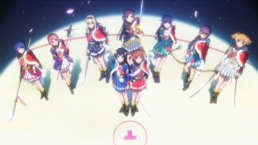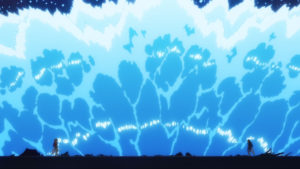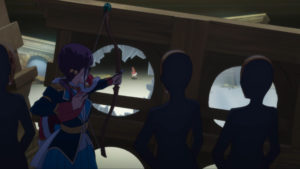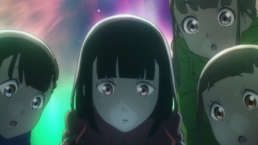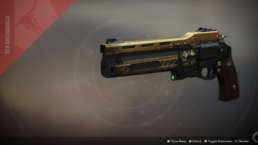Review: Shoujo☆Kageki Revue Starlight Anime
In Short:
On its surface, Revue Starlight is an anime about nine young women who attend an all girls music and stage production school. They learn to sing and dance and act and perform as you might expect. But, when they aren’t attending academic or artistic classes, these same girls are called to fantastical Revue auditions where they must literally fight each other, weapons in hand, in thrilling, character revealing, one-on-one musical stage battles for the right to be their class’ Top Star.
Revue Starlight, to its credit, is built around a detailed, veiled criticism of the Takarazuka Revue style of stage shows and music schools, but some viewers may be unfamiliar with these real world contexts, leaving them lost to the show’s finer points.
Suggested Minimum Watch: 1 episode. The first episode encapsulates both the mundane slice of life and fantastical Revue sides of the show well enough to let you know what you’re getting into.
Full Review:
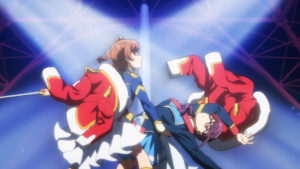 It was the stage battles of Revue Starlight that first caught my eye. They looked like something out of a Magical Girl anime with flashy transformations and superhuman movements. That the show also seemed to focus somewhat on the behind the scenes aspects of a performing arts training school interested me, as well, since I tend to enjoy anime that really know their real world influences. In some ways, I got a bit more than I bargained for as you’ll see in the Dig Deeper segment at the end!
It was the stage battles of Revue Starlight that first caught my eye. They looked like something out of a Magical Girl anime with flashy transformations and superhuman movements. That the show also seemed to focus somewhat on the behind the scenes aspects of a performing arts training school interested me, as well, since I tend to enjoy anime that really know their real world influences. In some ways, I got a bit more than I bargained for as you’ll see in the Dig Deeper segment at the end!
In the first episode, we are introduced to eight girls who attend Seisho Music Academy. They do everything together from attending typical academic classes to participating in all the different dance, acting, and performing arts classes you might find at a music academy. For the most part, the cast is split into pairs early on. Our main character, the energetic yet lazy Karen Ajio gets paired up with the more reserved and responsible Mahiru Tsuyuzaki. The most accomplished dancer and actress in the class, Maya Tendo, often gets paired off with her competitive rival the French-Japanese Claudine Saijo. And so it goes. Each of these pairings end up carrying through the anime’s twelve episodes with transfer student Hikari Kagura throwing a wrench into the balanced mix by the end of the first episode.
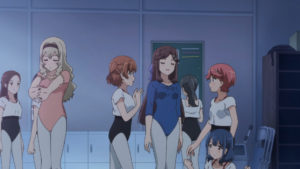 In and out of class, the girls are relatively friendly, but there is an air of competition between some of them that complicates things. Others have different personal issues that need to be worked through. For instance, elegant hometown star Kaoruko Hanayagi’s over reliance on her long time friend Futaba Isurugi eventually becomes an issue. There’s also the soft spoken but intelligent and hard working Junna Hoshimi and the capable but surprisingly motherly Nana Daiba who form a strong bond later in the series after a shared revelation.
In and out of class, the girls are relatively friendly, but there is an air of competition between some of them that complicates things. Others have different personal issues that need to be worked through. For instance, elegant hometown star Kaoruko Hanayagi’s over reliance on her long time friend Futaba Isurugi eventually becomes an issue. There’s also the soft spoken but intelligent and hard working Junna Hoshimi and the capable but surprisingly motherly Nana Daiba who form a strong bond later in the series after a shared revelation.
If Revue Starlight were merely a slice of life show focused solely on these girls and their preparations for their upcoming stage show “Starlight” it would passable but a little dull. All the characters are generally likable, and there are minor conflicts, but there’s just no intense spark between any of them that makes you sit up and take notice. That’s because the show is saving its biggest emotions and character moments for the stage.
At the end of each day of classes, most of the girls receive a strange text message with the cute icon of a giraffe inviting them to special Starlight Revues. The girls enter a not normally there elevator within the school and are brought down deep underground to a giant circular stage surrounded by an even larger pool of water all beneath a bizarrely underground version of Tokyo Tower. Here, their singing, acting, and combat abilities(?!) are pitted against one another in one on one stage battles.
These Revues make up the core strength of the show. They are fantastical and highly reflective of each’s girl’s almost magical stage presence. The Stage of Fate they fight on often shifts and changes in response to the current combatants’ deepest thoughts and desires, and in response to who currently has the upper hand in the performance. Backgrounds, which can be anything from brightly painted cardboard flames to abstract city sets, often magically move in and out as if part of a stage play. The girls themselves transform as if they’re part of a Magical Girl anime. They fight in fancy military dress uniforms instead of the clothes they are wearing when they arrive at each Revue.
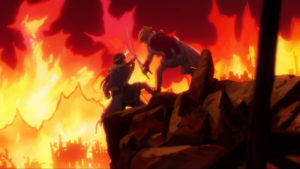 The girls clash their weapons and leap to impossible heights and dodge and tumble as part of these battles, but there is always a strong theatrical element involved. They move with a dancer’s grace and follow dramatic stage direction that sometimes even sees them coordinate their singing and dancing as if part of a stage musical. Despite the clang of weapons, there isn’t any actual violence in these Revues. I can’t remember even a single time that any of the girls actually get hurt in the several Revues they attend. Their goal isn’t to stab or maim their opponents. Instead, they try to cut the tie that holds their opponent’s cape-like overcoat on their shoulder so it falls to the ground.
The girls clash their weapons and leap to impossible heights and dodge and tumble as part of these battles, but there is always a strong theatrical element involved. They move with a dancer’s grace and follow dramatic stage direction that sometimes even sees them coordinate their singing and dancing as if part of a stage musical. Despite the clang of weapons, there isn’t any actual violence in these Revues. I can’t remember even a single time that any of the girls actually get hurt in the several Revues they attend. Their goal isn’t to stab or maim their opponents. Instead, they try to cut the tie that holds their opponent’s cape-like overcoat on their shoulder so it falls to the ground.
The Revues always feature two different girls paired off against each other, but the real thing keeping each Revue interesting is that they have a larger point than just seeing which girl is better with their chosen weapon. The Revues are not really about the physical combat at all. Instead, each Revue highlights the various girls’ interpersonal conflicts. One early Revue highlights how one of the girls came to see being on stage as a way to free herself from her childhood shyness and how her opponent’s newfound success threatens to take the shy girl’s stage, and confidence, away. Another Revue is squarely focused on demonstrating that one girl’s spirit and enthusiasm by themselves are not nearly enough to overcome another girl’s innate talent.
While these Starlight Revues are the heart of the show, Revue Starlight actually manages to tie its flashy combat back into its stage girls’ daily lives in interesting ways. The lessons about kindness, hard work, jealousy, and sacrifice the girls learn during their Revues often change them for the better off the stage. But, more than that, Revue Starlight tells a satisfyingly cohesive overall story with a couple of twists and turns along the way. I appreciate the way it broke up details about the Starlight Revues and about its characters’ motivations and backstories. You don’t learn everything all at once, but the pacing delivers new revelations almost on an episode by episode basis.
If I was to levy any criticism of the show’s plot, it’s that the school’s two top ranked stage girls, Maya and Claudine, don’t get the backstory episodes they deserve. Each has a big personality and have hints at compelling pasts, but we never dive in. And that’s a shame.
Oh, and I guess I should address the elephant in the room. Or, more specifically, the giraffe. These magical Revues are coordinated and overseen by a full-sized, deep-voiced, telepathic talking giraffe. It is the giraffe who introduces girls to the Revues and who sets the schedule for who battles who each day. Yes, his inclusion is strange, and while I don’t want to spoil everything about him, you should listen to what he says, as his plainly stated desires and love of the stage make up a small but important part of the show’s plot.
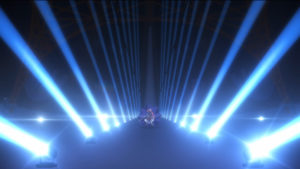 In terms of art and animation, Revue Starlight ranges from good to stunningly great. Once again, the Revues represent its heights. Most start with brilliant character introductions featuring larger than life statements of intent while a dazzling array of spotlights light up the screen in ways that left me breathless. The on-stage combat is also generally well done with nice use of sparks and some fun combat flourishes. Computer animation occasionally pops up, but generally only to animate the spotlights or provide a handful of really good sweeping camera moves that would be difficult to pull off with hand drawn animation alone.
In terms of art and animation, Revue Starlight ranges from good to stunningly great. Once again, the Revues represent its heights. Most start with brilliant character introductions featuring larger than life statements of intent while a dazzling array of spotlights light up the screen in ways that left me breathless. The on-stage combat is also generally well done with nice use of sparks and some fun combat flourishes. Computer animation occasionally pops up, but generally only to animate the spotlights or provide a handful of really good sweeping camera moves that would be difficult to pull off with hand drawn animation alone.
Outside of the Revues, character designs, and, oddly enough, some very tasty depictions of meals are Revue Starlight’s biggest strength. Each of the nine girls is unique and identifiable and some of the food that Nana “Banana” Daiba cooks for her friends just looks delicious.
The only real criticisms I have of Revue Starlight’s art is that the show is well known to have run out of time and budget by the end. It never gets bad, but if you pull yourself out of the moment and watch closely, it does become apparent that the breathtaking combat animations and scene changes of the show’s earlier Revues give way to slow pans across unanimated still shots by the final big battle. The show always reaches for greatness, and still delivers some excellent animation here and there even at its low point, it’s just unfortunate the creative team wasn’t given the budget or time necessary to fulfill the entirety of their vision.
Soundwise, Revue Starlight is uniformly excellent. I’d expect nothing less given that Yoshiaki Fujisawa is involved. His work on A Place Further Than The Universe and Land of the Lustrous was outstanding. The characters, here, have distinct voices and are well acted in both the Japanese and English language tracks. The songs the girls sing in the middle of their Revue battles are catchy and the lyrics they sing at each other are actually surprisingly important and impactful. “Star Divine”, the battle song for episode ten’s Revue, “The Star Knows” sung in the 2nd Revue, and “Re:Create” which plays a pivotal role in the 8th episode are all especially noteworthy. Be sure to turn on the song subtitles or you’ll really will miss out during the series. The song lyrics are very important since they are how each girl primarily expresses her mood and reason for becoming a stage girl.
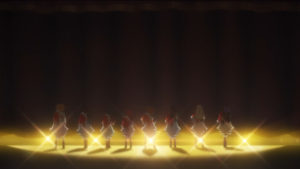 Finally, I’d like to pay special note to Revue Starlight’s opening and its multiple closings. The opening starts with this nice look at the main characters set to a slow stage curtain opening before it transitions through fun slice of life moments and on to showing the type of combat featured in the Revues. The opening song Hoshi no Dialogue (Dialogue of the Stars) is great, too. The endings are neat in that most of the episodes have similar but distinct end credits sequences based on the primary character or characters who just took part in that episode’s Revue.
Finally, I’d like to pay special note to Revue Starlight’s opening and its multiple closings. The opening starts with this nice look at the main characters set to a slow stage curtain opening before it transitions through fun slice of life moments and on to showing the type of combat featured in the Revues. The opening song Hoshi no Dialogue (Dialogue of the Stars) is great, too. The endings are neat in that most of the episodes have similar but distinct end credits sequences based on the primary character or characters who just took part in that episode’s Revue.
All In All:
Revue Starlight is an interesting anime with a unique premise. The way which it uses its magical stage play Revues to resolve various emotional and status based conflicts between its cast members is like nothing I’ve ever seen before. I love that the songs being sung by the characters in the midst of combat often mattered as much or more than the action within their fantastical stage battles. If you love anime with music and theatrics, you should at least give this a one episode try.
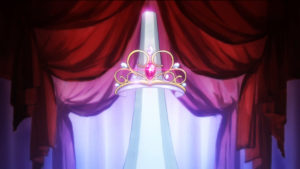 Interestingly, Revue Starlight has yet another hidden side that really pulled me in. Almost everything in the show from the varied heights of its characters to the small pink lens flare glows that are present in almost every single background serve as a veiled criticism of the real world stage shows and music schools of Japan’s Takarazuka Revue. We’ll need to Dig Deeper and enter spoiler territory to really talk about this aspect of the show, but the basics are that Revue Starlight actually speaks out quite strongly against the 100+ year old practices of pitting actresses against each other in competitions where only a handful can reach the highly revered yet highly regulated position of a Top Star.
Interestingly, Revue Starlight has yet another hidden side that really pulled me in. Almost everything in the show from the varied heights of its characters to the small pink lens flare glows that are present in almost every single background serve as a veiled criticism of the real world stage shows and music schools of Japan’s Takarazuka Revue. We’ll need to Dig Deeper and enter spoiler territory to really talk about this aspect of the show, but the basics are that Revue Starlight actually speaks out quite strongly against the 100+ year old practices of pitting actresses against each other in competitions where only a handful can reach the highly revered yet highly regulated position of a Top Star.
Because of all this, I highly encourage you to watch Revue Starlight then come back here to learn more about the sharp criticisms it is voicing, or, if you aren’t afraid of spoilers, continue along with me and learn about the show’s hidden depths so that you can go in with a better understanding of everything you are about to see.
Revue Starlight is actually one of the more interesting shows with one of the most well organized subtexts I’ve ever seen. In addition to its already tightly woven plot about the power of a long held promise, just about every aspect of the show also works to demonstrate the flaws of the real world Takarazuka Revue system. This is going to require a bit of a history lesson, so bear with me.
The Takarazuka Revue is a stage show company that was founded in 1913 by a Japanese railroad tycoon in the city of Takarazuka, Japan. The city had become a tourist city at the final stop of a rail line and in order to further boost the city’s tourist potential, this tycoon created an all girls theater that quickly grew in popularity and status. The theater eventually formed the Takarazuka Music School, an elite acting school similar to the one in the anime. This school only accepts a few of dozen young women each year. The real life school is very strict and the actresses compete against each other to become one of the handful of “Top Stars” maintained by the company at any given time.
There’s an extra wrinkle there, though. Even though the company puts on a wide variety of shows with male and female parts, think Romeo and Juliet or Phantom of the Opera, all the parts are played by female actresses. To accomplish this, the girls joining the school are split up at the end of their first year into Otokoyaku (boy role) and Musumeyaku (girl role) groups. Sadly, only Otokoyaku are eligible to become Top Stars, and typically they are paired with a single Musumeyaku whose job it is to support their performance and popularity until they retire. Tragically, retirement usually happens just a few short years after an actress obtains one of the Top Star positions since it takes so long to reach that level and since once there, the actress is at the top. There’s nowhere left to go.
In the Takarazuka system, young women compete fiercely with each other while, right off the bat, half of them have no hope of earning the most money and fame because only the ones sorted as Otokoyaku even have the potential to become a Top Star. Those are just the rules. That sorting is almost entirely based on physical attributes such as height, vocal tone, and looks. Things like acting ability and singing ability are secondary. To be a Top Star, you have to fit a certain predefined mold and everyone else is treated as significantly lesser than the Top Stars.
Just as there is only a singe Otokoyaku in each troupe, there is also only a single Musumeyaku, as well. You’d think that would make them equal, but it doesn’t. In reality, there is enormous pressure put on the Musumeyaku to support their Otokoyaku. If there’s a mistake the Otokoyaku makes, the Musumeyaku takes the responsibility. If there’s an opportunity to boost the Otokoyaku’s popularity, the Musumeyaku is obligated to pursue it. It’s the Musumeyaku’s job to enhance the desirability and fame of their Otokoyaku, but the reverse is never true.
The Top Star is the only one who truly matters in this system, but there is a ton of pressure and isolation demanded of the Otokoyaku, as well. In the past, there were strict rules like no romantic relationships for anyone at the school, especially either the Otokoyaku or Musumeyaku pairs since they have to remain potentially available to all their fans. Girls at the school or in one of the troupes, especially the Otokoyaku or their Musumeyaku, were also forbidden from receiving or responding to fan mail as well. These kinds of rules and restrictions, combined with the fierce competition to become a Top Star, led to a lot of burnouts, bullying, lawsuits, and even suicides over the years. The Takarazuka Revue has cleaned up its image a good bit in the modern age, and it has cut back on some of its rules, but all these problems still linger over it to some extent.
We can see so many aspects of the Takarazuka Revue system within Revue Starlight. For instance:
Why are Maya Tendo and Claudine Saijo generally seen as the school’s two top students? Why does the always cheerful and motherly Nana “Banana” Diaba have the ability to surpass the both of them as seen later in the series? The answer is that Maya and Banana have all the physical attributes like height and stature they need to become Otokoyaku in the Takarazuka Revue system. Claudine comes close, but ultimately she is too girly and in the real world she would have been seen as a top performing Musumeyaku. And that’s exactly where she ends up! The way Claudine breaks down in episode ten and takes responsibility for Maya’s loss are classic Musumeyaku tendencies drilled into those counterpart women who are forbidden from reaching Top Star status. Sadly, someone as hard working and skilled as Futaba Isurugi would never be considered an Otokoyaku. I believe we see her lose out to Maya, Claudine, and even her friend Kaoruko over the course of the series for largely for these reasons. (Though her loss to Kaoruko is actually its own interesting character study… Their relationship was always based on Futaba supporting and following Kaoruko. If Futaba had won, it would have driven them completely apart which neither actually wanted.)
Similarly, look at the way the Revues are set up. The girls are all battling to become the Top Star, but we later learn that the Top Star usually robs their rivals of their Shine. This is one of the real world criticisms leveled at the Takarazuka Revue system. A small handful of women, one from each acting troupe, achieve Top Star status. These women are the ones to get the fame and press and money while all the other candidates are treated as mere actors. This can be devastating to those who fail to reach the exclusive Top Star position. Revue Starlight takes this even further as we see Hikari Kagura and later Karen Ajio straight up lose the will to continue their careers after losing out to their class’ Top Star. That Karen’s ultimate loss was to her best friend just made things all the more tragic!
With all this in mind, take note of just how often our main character Karen Ajio goes against the Takarazuka Revue system. Her promise to Hikari is for them to share the spotlight… in direct contrast to the Top Star system that recognizes one actress above all others. Her declaration at the end of her transformation sequence, “We will all do Starlight!”, sets it up for all her classmates to join her as equals on the stage which, again, is the opposite of the normal Top Star system.
In contrast, look at Maya and Claudine. Both of them never really had any competition until they met each other. And how do they eventually end up? As an Otokoyaku and Musumeyaku pair determined to claim their first and second place roles from within the Takarazuka Revue system! It’s not an accident that these two represent one of the final obstacle our main characters have to overcome.
It’s all this history and deliberate veiled criticism that I think propels Revue Starlight past its merely average presentation to become one of the more interesting anime I’ve had the pleasure to dig deeper into. But that’s not all there is to say. I didn’t know any of this when I started Revue Starlight, and I almost abandoned it because of that. But then, I caught a series of videos and articles that go into even more detail and saved the show for me:
- Under The Scope’s Building A Stage Girl: Behind The Scenes with Revue Starlight Staff and Staging The Story: The Visual Theater of Revue Starlight
- Emily Rand’s Atelier Emily blog has multiple articles discussing the symbolism of Revue Starlight.
- Andrea Ritsu’s Between The Revues series focusing on the origins and problems with Takarazuka Revue
Review: A Place Further Than The Universe
In Short:
A Place Further Than The Universe is a 2018 anime by Madhouse that follows the challenges and triumphs of four Japanese high school girls who become the best of friends after choosing to join a research expedition to Antartica. The show features strong art and animation, great characterizations for its four leads, a realistic portrayal of just what it takes to go on such a journey, a ton of great humor and funny moments, and a surprising amount of depth and heartache that you might not expect given the show’s premise and early episodes.
Suggested Minimum Watch: 1 episode. If you don’t love the show by the end of the end credits train ride you’d be better off finding something else.
Full Review:
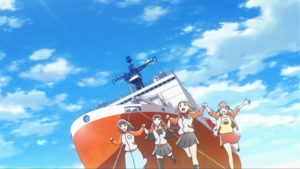 When I first saw the key art and heard the initial pitch for A Place Further Than The Universe, I almost immediately put it in my ignore pile. The premise of four high school girls going on an adventure to Antartica just seemed too cutesy to me. The visuals reminded me a bit too much of shows like Girls und Panzer and High School Fleet, two shows where groups of girls join their school’s tank club or crewed warships with no adults and no real risks or dangers. I figured A Place Further Than The Universe was like that. Cutesy without any real substance. Turns out I was super wrong! Instead, this is a show that is both packed with humor and laughs, and one that tells a surprisingly character focused coming of age story.
When I first saw the key art and heard the initial pitch for A Place Further Than The Universe, I almost immediately put it in my ignore pile. The premise of four high school girls going on an adventure to Antartica just seemed too cutesy to me. The visuals reminded me a bit too much of shows like Girls und Panzer and High School Fleet, two shows where groups of girls join their school’s tank club or crewed warships with no adults and no real risks or dangers. I figured A Place Further Than The Universe was like that. Cutesy without any real substance. Turns out I was super wrong! Instead, this is a show that is both packed with humor and laughs, and one that tells a surprisingly character focused coming of age story.
The show begins with Mari Tamaki, a second year Japanese high school student who wakes up one morning and realizes that she hasn’t really done anything with her life. Desperate to go on an adventure, she attempts to skip class one morning but chickens out and ends up at school on time, same as always. That evening, on her way home, she happens to pick up a bank envelope dropped by an unknown girl from school who rushes by. Inside is a million yen! Mari manages to track down the owner the next day and is introduced to Shirase Kobuchizawa, a girl her age who is determined to make her way to Antartica.
After a bit of a rough start, the two girls hit it off and soon come in contact with Hinata Miyake, an intelligent, upbeat girl their age who works full time while studying for college, and Yuzuki Shiraishi, a girl from out of town who is a year younger than them and who is a childhood actress and social media star. She is being forced to accompany an expedition to Antartica to record a social media type documentary.
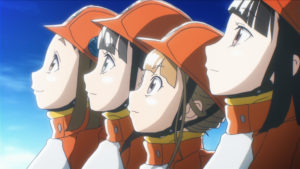 These four girls are the main reason to watch A Place Further Than The Universe. Each has a distinct personality, and a distinct reason for wanting to go to Antartica.
These four girls are the main reason to watch A Place Further Than The Universe. Each has a distinct personality, and a distinct reason for wanting to go to Antartica.
- Mari is goofy and upbeat, but, having done very little beyond obtain perfect attendance and excellent grades at school, she is a little sheltered as to how the real world works. She wants to go on the trip so she can say she actually did something.
- Hinata is fun loving, athletic, and smart enough to become the brains of the group, but she tends to hide her troubles behind a laugh and a smile. She says she just wants to do something big before entering university, but her stated reasons for dropping out of school aren’t the whole story.
- Yuzuki is essentially the girls’ ticket to Antartica. Her mother is helping fund the expedition and Yuzuki is set to record a fun, social media heavy show detailing her trip. Sadly, because she’s been a child actress for as long as she can remember, Yuzuki has never had much time for friends. Worse, often any friends she does try to make care more about her popularity than actually getting to know her.
- Then there’s Shirase. At the start of the story she has a somewhat cynical, reserved personality and her plans are often a little under-thought, but she is determined to get to Antartica as part of the upcoming public expedition absolutely no matter what. You see, her mother was a member of the previous research expedition that left for Antartica more than three years ago. But, while the rest of the team returned home, Sirase’s mother did not. She was lost in a blizzard, never to be seen again.
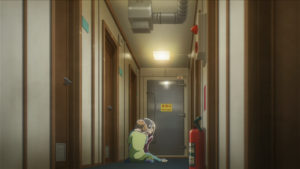 A Place Further Than The Universe is a show filled with jokes and laughs and humorous situations, mostly of the four girls’ making, but it is also a show that has a more serious undercurrent. Though it’s not obvious at first, each of the four girls has some obstacle in their life that they wish they could overcome, and the friendships they form with each other during their joint trip to Antartica helps them do just that.
A Place Further Than The Universe is a show filled with jokes and laughs and humorous situations, mostly of the four girls’ making, but it is also a show that has a more serious undercurrent. Though it’s not obvious at first, each of the four girls has some obstacle in their life that they wish they could overcome, and the friendships they form with each other during their joint trip to Antartica helps them do just that.
The resolution to Shirase’s troubles had me in full on tears like no anime has before or since. The full stories of the other three girls turned out to be pretty impactful, as well, and serve to further illustrate the strong bonds of friendship they form along the way. The friendships these four girls make on their journey, combined with the emotional payoffs to their individual stories, puts this anime on a different level than many of its peers.
Beyond its four main characters, A Place Further Than The Universe boasts a surprisingly solid look at what it takes to attempt an expedition to Antartica. There’s an episode dedicated to training for the trip. There’s an episode just about exploring the ship that will be their home for the weeks long journey. There’s an episode all about life on board the icebreaker as it sails from Australia to Antartica. Although issues like loading supplies, or obtaining funding, or the sacrifices people make to go on such an expedition are never super heavily focused on, they all come up during the course of the series. Really, what I thought would be the four girls’ unrealistically goofy adventure actually turned out to kinda be the opposite. There is realism to spare here, and the show is all the better for it.
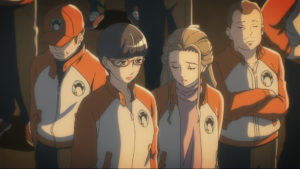 In a show about high school girls going on an adventure, a decent amount of attention is given to the secondary adult characters, as well. In particular, Mission commander Gin Todo and vice commander Kanae Maekawa, both of whom were close friends of Shirase’s mother, have standout minor roles. Gin’s relationship, or lack thereof, with Shirase is one of the high points of the series. The loss of Shirase’s mother, who was friends with most of the returning crew, is keenly felt throughout the second half of the show. Not in any big way, but there’s a subtle acknowledgment of sadness and a determination to try again despite the last trip ending in tragedy that makes things feel ever more real.
In a show about high school girls going on an adventure, a decent amount of attention is given to the secondary adult characters, as well. In particular, Mission commander Gin Todo and vice commander Kanae Maekawa, both of whom were close friends of Shirase’s mother, have standout minor roles. Gin’s relationship, or lack thereof, with Shirase is one of the high points of the series. The loss of Shirase’s mother, who was friends with most of the returning crew, is keenly felt throughout the second half of the show. Not in any big way, but there’s a subtle acknowledgment of sadness and a determination to try again despite the last trip ending in tragedy that makes things feel ever more real.
That’s not to say this show isn’t also goofy and enjoyable, because it certainly is. The girls’ antics had me cracking up more often than not while watching this series. They joke and goad and screw up and make amends and grow as people in the funniest ways that feel authentic to four high school girls tagging along to Antartica. The show does a great job balancing the handful of truly sad moments with the general sense of cheerfulness and adventure that it puts forth most of the time.
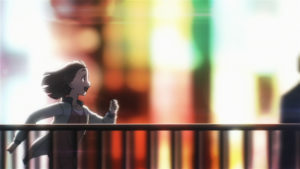 A Place Further Than The Universe is also a beautifully animated series. When it wants to, it’s artistry can rival even anime like Your Name or Violet Evergarden. In particular, it pulls some of the same tricks we see in Makoto Shinkai films where it recreates the look and feel of real world locations with a great attention to detail. The real life Antarctic base of Syowa Station really comes alive in animated form, as do the tourists areas of Singapore and the port areas of Australia’s Fremantle. The show also often goes above and beyond on its animation. A goofy chase scene in the second episode is fantastically well done, but just everywhere you look there are extra touches and flourishes to both the foreground and background characters that help enliven each and every scene.
A Place Further Than The Universe is also a beautifully animated series. When it wants to, it’s artistry can rival even anime like Your Name or Violet Evergarden. In particular, it pulls some of the same tricks we see in Makoto Shinkai films where it recreates the look and feel of real world locations with a great attention to detail. The real life Antarctic base of Syowa Station really comes alive in animated form, as do the tourists areas of Singapore and the port areas of Australia’s Fremantle. The show also often goes above and beyond on its animation. A goofy chase scene in the second episode is fantastically well done, but just everywhere you look there are extra touches and flourishes to both the foreground and background characters that help enliven each and every scene.
The show is no slouch musically, either. The main theme is upbeat and enjoyable, but it’s the reoccurring insert song Haru ka Tooku (roughly, “No Matter How Far”), that gets played during moments of friendship and forward movement that really gets me. The music knows just when to come in to perfectly enhance moments of adventure or sadness.
All In All:
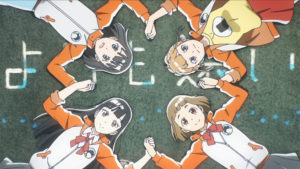 A Place Further Than The Universe is something I did not expect. It is hilarious, charming, heartwarming, and occasionally tear jerking. And it’s all based on the strength of its characters and the journey they go on together. Plus, and this is a minor point, it wasn’t made to sell an incomplete manga or light novel. It was made solely to be a great anime, something that is fairly unique these days.
A Place Further Than The Universe is something I did not expect. It is hilarious, charming, heartwarming, and occasionally tear jerking. And it’s all based on the strength of its characters and the journey they go on together. Plus, and this is a minor point, it wasn’t made to sell an incomplete manga or light novel. It was made solely to be a great anime, something that is fairly unique these days.
Review: Planetes Anime
In Short:
Planetes is a well made, character-driven anime that depicts life and work in Earth’s orbit in the near future of 2075. Its realistic portrayal of space, combined with its complex, well-rounded ensemble cast, delivers humor and fun along with a strong helping of angst and character drama.
Even though its art direction is top notch, Planetes is an older series, and that sometimes shows up in art you’ll wish matched up better with today’s higher resolutions.
Suggested Minimum Watch: 1 episode. You get to meet most everyone and you get to hear the first of Tanabe’s several epic rants about love.
Full Review:
It was something of a Space Week last week for me and millions of others across the globe as SpaceX launched two Astronauts on a test flight of their new Dragon crew capsule. I celebrated in a bunch of different ways: I finally got around to building my LEGO International Space Station. I listened to podcast about the Apollo program. I watched my copy of Apollo 13 (the director commentary this time.) But even after the docking I still wanted to do something else, so I’ve loaded up my copy of the 2003 anime Planetes and have been having a blast rewatching it.
There are several great anime set in space. Obviously, I have the entire Macross Frontier Episode Guide here at my site, but I also love anime like Cowboy Bebop, Space Battleship Yamato 2199, Aldnoah.Zero, and Strain: Strategic Armored Infantry. One thing all these anime have in common, however, is though they may be set in space, they are generally not about space. There is one anime, though, that is different. One that explores what the near future of life in orbit might be like. And it is great!
 Released in 2003, Planetes primarily follows the lives of six members of a fictional space-based corporation called Technora in the year 2075. Based out of a large space station in earth orbit, Technora is made up of a number of different divisional Sections each with their own jobs and responsibilities. Our main cast doesn’t work in the Control Section which acts as the space station’s air traffic control, nor do they work in Administrative section or Engineering Section or Accounting Section… no, they work for Technora’s much derided Debris Section. Their job is to go out in an old beat up cargo shuttle and retrieve or deorbit space debris before it can collide with other ships, satellites, or stations. They are essentially Space Trash Collectors, and while their jobs are important to help keep earth’s orbit free of dangerous space junk, they aren’t paid particularly well and don’t contribute much to Technora’s bottom line.
Released in 2003, Planetes primarily follows the lives of six members of a fictional space-based corporation called Technora in the year 2075. Based out of a large space station in earth orbit, Technora is made up of a number of different divisional Sections each with their own jobs and responsibilities. Our main cast doesn’t work in the Control Section which acts as the space station’s air traffic control, nor do they work in Administrative section or Engineering Section or Accounting Section… no, they work for Technora’s much derided Debris Section. Their job is to go out in an old beat up cargo shuttle and retrieve or deorbit space debris before it can collide with other ships, satellites, or stations. They are essentially Space Trash Collectors, and while their jobs are important to help keep earth’s orbit free of dangerous space junk, they aren’t paid particularly well and don’t contribute much to Technora’s bottom line.
There are a two main things that make Planetes something of a must watch anime:
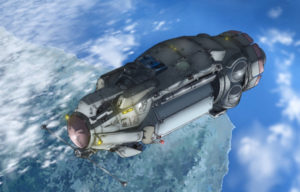 1. It is set in a near future of commercial space operations that you can almost see from the here and now if you squint hard enough. Planetes gets almost everything about space right. Spacesuits are big and bulky. Moving around in zero gravity is tough to get a hang of. Ships don’t zip about or change directions easily even when their engines are at full power. And, of course, engines, thrusters, and, heck, even laser defense satellites make zero noise out in the vacuum of space.
1. It is set in a near future of commercial space operations that you can almost see from the here and now if you squint hard enough. Planetes gets almost everything about space right. Spacesuits are big and bulky. Moving around in zero gravity is tough to get a hang of. Ships don’t zip about or change directions easily even when their engines are at full power. And, of course, engines, thrusters, and, heck, even laser defense satellites make zero noise out in the vacuum of space.
We get to see everything from moon colonies, to astronaut training, to a spaceship capable of transversing the solar system, but it’s all done in ways that makes a whole lot of sense given where actual space technology seems to be going. Planetes’ realistic vision of life in space is easily one of the best out there in any medium.
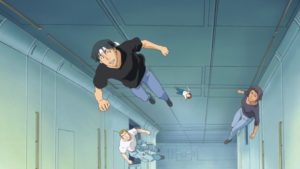 2. Its complex, well rounded characters and their relationships drive the show. Yes, there are some interesting plots and happenings that put our Debris Section employees into challenging situations, but more so it’s the hopes, fears, and desires of our main cast that push them into places they never thought they would, or could, end up. Sometimes, their journeys are a struggle. Not everyone is ascendent. Not everyone achieves their goals. And the ones that do sometimes take routes that both they, and their colleagues, wish they hadn’t.
2. Its complex, well rounded characters and their relationships drive the show. Yes, there are some interesting plots and happenings that put our Debris Section employees into challenging situations, but more so it’s the hopes, fears, and desires of our main cast that push them into places they never thought they would, or could, end up. Sometimes, their journeys are a struggle. Not everyone is ascendent. Not everyone achieves their goals. And the ones that do sometimes take routes that both they, and their colleagues, wish they hadn’t.
That’s not to say Planetes is depressing or all about drama, drama, and more drama. It, and its characters, have good times as well as bad. The members of Debris Section, in particular, are mostly oddballs that are somewhat looked down upon. They don’t have a lot of staff. They have barely any corporate influence at all. But, on the plus side, it means that they aren’t all that closely supervised and can get away with a good bit of goofing off and trouble making that the more respectable sections, like Control Section, could only dream of.
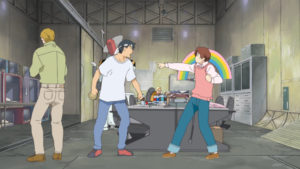 On top of that, some of the main cast can get pretty eccentric at times. Take Ai Tanabe, the newest, most inexperienced member of Debris Section who will, at the drop of a hat, yell your head off about how life is not worth living without love even as everyone around her scoffs or mocks her for it. Or, take Fee Carmichael, Debris Section’s primary ship pilot whose addiction to smoking, despite living in space where it is almost universally forbidden, leads to one of the most exciting moments in the series. Then there’s Debris Section’s second in command, Arvind “Robbie” Lavie, who is such a bend over backwards yes man completely devoted to pleasing the highest ranking person in the room that his antics drive a decent portion of the show’s comedy.
On top of that, some of the main cast can get pretty eccentric at times. Take Ai Tanabe, the newest, most inexperienced member of Debris Section who will, at the drop of a hat, yell your head off about how life is not worth living without love even as everyone around her scoffs or mocks her for it. Or, take Fee Carmichael, Debris Section’s primary ship pilot whose addiction to smoking, despite living in space where it is almost universally forbidden, leads to one of the most exciting moments in the series. Then there’s Debris Section’s second in command, Arvind “Robbie” Lavie, who is such a bend over backwards yes man completely devoted to pleasing the highest ranking person in the room that his antics drive a decent portion of the show’s comedy.
Every member of the Debris Section, and quite a few of the lesser cast of characters, all have senses of humor, and personal sticking points, and reasons for why they behave the way they do. There are friendships made and broken. Arguments that persist a long time only to finally be resolved. And choices that make total sense but will, at the same time, have you wanting to grab hold of characters and shake them, and make them realize just what they are doing to themselves and others.
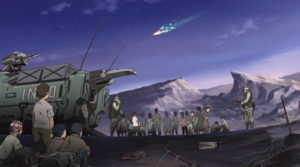 Another reason I like it is Planetes speaks to bigger things. With so many realistically portrayed characters, it kinda has to. As the show progresses, it touches on things like: national economic disparity, racism, abusive relationships, corporate greed, dying with dignity, harsh uncompromising determination, and more. But, again, Planetes isn’t a depressing show by any means. There are plenty of friendships and growing moments and characters finding the strength to overcome their troubles or hold fast to their ideals, too.
Another reason I like it is Planetes speaks to bigger things. With so many realistically portrayed characters, it kinda has to. As the show progresses, it touches on things like: national economic disparity, racism, abusive relationships, corporate greed, dying with dignity, harsh uncompromising determination, and more. But, again, Planetes isn’t a depressing show by any means. There are plenty of friendships and growing moments and characters finding the strength to overcome their troubles or hold fast to their ideals, too.
 Animation wise, Planetes is decent, but there’s always a sense that it sure would have been great if it had been made in 2013 instead of 2003. Don’t get me wrong, ships and stations and characters and background are all pretty well detailed and animated, but the show does maybe lack the sort of awe inspiring grandeur that a realistic show set in 2075 made more recently might otherwise have. In particular, I wish some of the shots of earth were crips, detailed, 4k backdrops instead of nice but somewhat blurry 2003 artwork. That said, everything space related is so well realized, plus this is one of the fairly rare shows that actually take the time to make good graphics for the things that appear on screens and reports, so that, at least, makes me happy.
Animation wise, Planetes is decent, but there’s always a sense that it sure would have been great if it had been made in 2013 instead of 2003. Don’t get me wrong, ships and stations and characters and background are all pretty well detailed and animated, but the show does maybe lack the sort of awe inspiring grandeur that a realistic show set in 2075 made more recently might otherwise have. In particular, I wish some of the shots of earth were crips, detailed, 4k backdrops instead of nice but somewhat blurry 2003 artwork. That said, everything space related is so well realized, plus this is one of the fairly rare shows that actually take the time to make good graphics for the things that appear on screens and reports, so that, at least, makes me happy.
All in All:
Planetes is a wonderful show for anyone who loves space. It gets so much right in so many areas that the few places it is lacking are almost just complete non-issues.
Bite-sized Backstory 57: The Showdown at Dwindler's Ridge
For decades, Shin Malphur hunts the man who killed his friend, mentor, father figure. Shin and Yor finally met atop a place called Dwindler’s Ridge. And… this is how it played out. I don’t often quote large portions of Grimoire Cards, my goal is to summarize and make available, not to copy and paste, but this showdown is one of my favorite scenes in all of Destiny’s lore. It is a scene that deserves to be read:
Now.
We stood silent, the sun high.
Seconds passed, feeling more like hours.
He looked different.
He seemed, now, to be weightless – effortless in an existence that would crush a man burdened by conscience.
My gaze remained locked as I felt a heat rising inside of me.
The other spoke…“Been awhile.”
I gave no reply.
“The gunslinger’s sword… his cannon. That was a gift.”
My silence held as my thumb caressed the perfectly worn hammer at my hip.
“An offering from me… to you.”
The heat grew. Centered in my chest.
I felt like a coward the day Jaren Ward died and for many cycles after.
But here, I felt only the fire of my Light.
The other probed…
“Nothing to say?”
He let the words hang.
“I’ve been waiting for you. For this day.”
His attempt at conversation felt mundane when judged against all that had come before.
“Many times I thought you’d faltered. Given up…”
All I’d lost, all who’d suffered, flashed rapid through my mind, intercut with a dark silhouette walking toward a frightened, weak, coward of a boy.
The fire burned in me.
The other continued…
“But here you are. This is truly an end…”
As his tongue slipped between syllables my gun hand moved as if of its own will.
Reflex and purpose merged with anger, clarity and an overwhelming need for just that… an end.
In step with my motion, the fire within burst into focus – through my shoulder, down my arm – as my finger closed on the trigger of my third father’s cannon.
Two shots. Two bullets engulfed in an angry glow.
The other fell.I walked to his corpse. He never raised his cursed Thorn – the jagged gun with the festering sickness.
I looked down at the dead man who had caused so much death.
My shooter still embraced by the dancing flames of my Light.
A sadness came over me.I thought back to my earliest days. Of Palamon. Of Jaren.
Leveling my cannon at the dead man’s helm, I paid one final tribute to my mentor, my savior, my father and my friend…
“Yours… Not mine.”
…as I closed my grip, allowing Jaren’s cannon, now my own, to have the last, loud word.
“Yours… Not mine.” is easily my favorite quote in all of Destiny. It was already a powerful line, but knowing the history of it, how it was both a confident, forceful statement, and a memorial to a lost friend, makes it so much better. It would make a great ending… but this is not the end of the story of The Last Word!
Unless killed in unusual ways, Guardians are immortal, meaning Shin does not just grow old and die happy. Similarly, the call of the Darkness and the Hive did not go away just because Shin put an end to Dredgen Yor. From here, Shin Malphur takes it upon himself to put a stop to any Guardian who would dare meddle with the powers of Darkness like Dredgen Yor did. And, once he becomes known as a feared boogeyman restlessly and ruthlessly devoted to the Light, Shin goes a step even beyond that…
I hope you’ll join me next time as we begin to delve into the frightening Legend and thought provoking truths behind The Man With The Golden Gun.
Bite-sized Backstory 56: Thorn vs The Last Word
For the next several years Jaren Ward stays at Palamon after freeing it from Magistrate Loken. We know that Shin Malphur thought of him as the town’s savior and eventually came to think of Jaren as a friend and father figure.
The Fallen were still a major problem for Palamon, however. It sounds like the town gets hit hard by Fallen raiders again. Jaren Ward and a few of the toughest survivors leave to give chase and possibly to prevent that group of Fallen from coming back. Four days later, someone new comes to what was left of the town. This man is tall and dark and solemn. Shin recalls that there was an intense sadness about him, but that he was polite and took up a room. This is Shin Malphur’s first time meeting Dredgen Yor.
Something happens soon after and we find Shin and a few others out in the wilderness having put Palamon’s “ash” to their backs. The lines get a bit hard to read between, but we learn that Shin and those with him were seeking vengeance for something. Could just be the fallen attack, but I think there’s a strong chance they are hunting Dredgen Yor. We have another transcript featuring the corrupted Guardian being drawn into a loud conversation with some local bandits one of which wants to see his gun, Thorn.
[u.1:0.1] Can I see what you got there?
[silence]
[u.1:0.2] Yer cannon…can I see it?
[beat]
[u.2:0.1] I know you?
[beat]
[u.1:0.3] Not that I can say.
[u.2:0.2] And you wanna hold my piece?
[beat]
[u.1:0.4] Just that I never…seen one like it.
[beat]
[u.2:0.3] No, you haven’t.
[u.1:0.5] Looks dangerous.
[u.2:0.4] Seems, maybe, that’s the point.
[u.1:0.6] Suppose so.
[u.1:0.7] Can I see it?
[u.2:0.5] Not likely.
Dredgen Yor banters with the leader of this group of four men for a bit and takes it unkindly when the leader states as “fact” that no one has ever been to the moon. The men begin to threaten Dredgen Yor and after warning them off in his own sort of way Yor finally has enough of their tough guy acts and guns three of them down. He saves the leader for last. This man who had wanted a look at Thorn now gets to stare down its barrel as Dredgen Yor explains to him about the nightmares of the Hive and how they will soon be coming for them all. And then the leader, too, is murdered.
Now, there is nothing that directly says this sorta old west bar room “conversation” happened in Palamon, but just nine days after Palamon is reduced to ash Shin Malphur and his group of Palamon survivors encounter Dredgen Yor again. I don’t think they were hunting Fallen because Shin notes that they had accidentally wandered into Fallen territory as they tracked the trail of something or someone. Along the way, some of Shin’s group are killed, “gunned down”, we’re told. But, what’s left of Shin’s group also meet up with Jaren Ward, and together they continue tracking their target. Jaren has an intense confidence that keeps the group going even though hope seems to be lost. But then, everything falls apart late one night.
A crack of gun fire then several more echo through the woods… These shots sound familiar, perhaps even comforting to the group. They’ve come from Jaren Ward’s prized hand cannon, but, tragically, they are not the last word this time, as one sickly, unfamiliar shot answers Jaren’s several. Afterward, there is only silence.
Everyone back at Shin’s camp knows what has happened. Jaren had gone out alone to engage “the other”, the same thing Shin termed Dredgen Yor when he met him, but this time Jaren Ward was not coming back. Those with Shin soon leave fearful for their lives. Shin, though, stays and searches for his mentor. Shin doesn’t find Jaren Ward, at least not at first. Instead, he finds Jaren’s still very much alive Ghost. The Ghost has something for Shin: Jaren Ward’s hand cannon. Dredgen Yor left it for Shin. How do we know? Because Dredgen Yor and Jaren Ward’s Ghost have a little conversation after Yor permanently kills Jaren Ward with a single shot from Thorn. The conversation between the two is interesting for a few reasons:
- Both the Ghost and Dredgen Yor agree that Shin Malphur is special. We know that of course, since we know Shin’s history of being revived in the Light by his long lost Ghost when he was nothing more than a baby. But we’ve also gotten some little indications that Jaren Ward and his Ghost knew Shin was special. We now learn that Dredgen Yor knew, as well.
- Dredgen Yor tells Jaren Ward’s Ghost to give his Guardian’s gun to Shin Malphur. Yor calls it a gift. He calls it giving the apprentice his master’s sword. The Ghost thinks that Yor is mostly just trying to further anger and sadden Shin.
- Jaren Ward’s Ghost calls Dredgen Yor a monster. Yor responds by alluding back to when his own Ghost called him that before they parted ways.
- Jaren Ward’s Ghost also argues that Dredgen Yor is not just a monster or an evil force of nature, but that he’s still a man that can be killed. And Dredgen Yor agrees that, yes, in that there is a sliver of hope.
Now there are two ways to look at this forth point, and I think both are valid. On one hand, Dredgen Yor is someone we have quoted as saying “Nothing dies like hope.” He is probably gifting Jaren Ward’s gun to Shin Malphur to fuel that hope so he can crush it too.
But, and we’ll get into this a whole lot more very soon, Dredgen Yor is also agreeing that there is hope that maybe he still is a man who can be stopped, who can be killed. It will take someone very special to stop him, Dredgen Yor knows, and maybe he thinks he’s found that person in Shin Malphur.
Next time I get to take y’all through one of my very favorite encounters in all of Destiny: The Showdown at Dwindler’s Ridge!
Ghost Fragment: The Last Word 4
Ghost Fragment: Thorn 2
Ghost Fragment: Thorn 3
Ghost Fragment: Thorn 4
Bite-sized Backstory 55: Rezyl Azzir & Dredgen Yor
If Jaren Ward was the embodiment of Light and Hope, Dredgen Yor was what you get when that hope dies. You see, long before the Titan we know as Dredgen Yor became perhaps the worst, most corrupted Guardian in history, he was a man known as Rezyl Azzir.
Rezyl was one of the Risen. One of those found by their Ghost before the Iron Lords, or The City, or the concept of Guardians existed. Rezyl, along with legends such as Zavala, Ikora Rey, and Lord Saladin saw to it that The City’s great walls were built in the first place. Rezyl was a hero, a bringer of hope. I love this quote about Rezyl Azzir:
The noble man stood. And the people looked to him. For he was a beacon – hope given form, yet still only a man. And within that truth there was great promise. If one man could stand against the night, then so too could anyone – everyone.
There are some great stories of Rezyl’s accomplishments. In one, he charges an entire Fallen Ketch on his sparrow knowing he’d be killed in the process. But he has a plan. He had his Ghost hang back. When the Fallen Kell and his troops came out to parade Rezyl’s lifeless body as a prize, Rezyl’s Ghost slipped into the crowd and quickly revived him. Alive again, Rezyl unloaded on the Kell with his hand cannon Rose and then:
In one motion, Rezyl rose from a crouch, his fists clenched and raised high as a storm of Arc Light built within him, his full might raining down on the Kell’s chest. The shockwave of Rezyl’s attack hit like a meteor, shattering the Kell’s body and any Fallen within the Havoc storm’s radius.
Through cleverness and strength, Rezyl had managed to kill a Fallen Kell, one of their highest ranking leaders!
In another story, Rezyl tracks a group of Fallen to a small town nestled in the snowy, tree covered mountains. Although it is not named, the town is almost certainly Palamon. Rezyl saves the town and leads those that are willing back to The City, but some stay behind. This might very well be the event that set Magistrate Loken down his bad path. And for Rezyl, this is yet another time that he does good and saves lives, but only after evil and suffering occur. We learn here that Rezyl is tiring of the endless war and is realizing that the good that he does is never enough.
By this point, Rezyl is a hero known far and wide beyond The City, but there are shadows growing in his mind. Shadows coming from a specific place. From the Moon! There were stories and legends of an evil far worse than the Fallen pirates that Rezyl and other Guardians had been fighting. This is a man who is already slowly losing hope after centuries fighting the Fallen, but Rezyl is also a proud man who is trying to push forward and be the hero he is expected to be despite his fears. So, at some point, Rezyl goes to investigate the strange calling he has been hearing from the moon.
On the moon, Rezyl soon finds and begins to investigate the Hive structures that have long been silent. This is long after the Hive emerged once before and killed thousands of Guardians, and long after Eris Morn and her fireteam managed to kill the Hive god Crota which banished him temporarily from our world. Rezyl’s Ghost notes that the Hive are all supposed to be gone. Once they lost Crota they fell silent… and yet the giant doors of the Hive structure Rezyl is investigating creek open for him as soon as he arrives. The Hive have been waiting for him. They have been calling to him. They invite him in.
Rezyl leaves his Ghost behind with instructions for it to run for help if he doesn’t return. He then proceeds down and down into the depths of the Hellmouth until he encounters waves of Hive being lead by a Hive Wizard. Rezyl does his best, but even his Rose is not enough to save him… and yet the Wizard and her Hive do not kill him. Instead she taunts him, goads him, and plays upon those fears that have been growing in his mind. She show him that the Hive are preparing to reemerge and that there’s nothing he nor The City will be able to do to stop them this time. And then, cruelest of all, she lets him leave.
Two days later, Rezyl emerges back on the lunar surface, but he has been permanently changed by his experience. One of the first things he does do is begin to affix some of the tough, cursed bones of the Hive he fought and killed to his hand cannon Rose. Later, perhaps after warning The City about the reemergence of the Hive, Rezyl spends one last day looking up at the moon while struggling with himself. He was a hero. Someone who spread hope wherever he went. He saved towns and killed alien leaders and helped establish a Last Safe City whose walls now guard millions. And yet, all he can do is look up at the moon in fear of what is coming.
In that cool evening air, as dusk was devoured by night, the noble man ceased to exist. In his place another stood.
Same meat. Same bone. But so very different.
The first and only of his family. The sole forbearer and last descendent of the name Yor.
In his first moments as a new being, he looked down at his Rose and realized for the first time that it held no petals: only the jagged purpose of angry thorns.
And so, the man that was Rezyl Azzir dies, and in his place stands Dredgen Yor. As Yor, Rezyl leaves a gash of death and destruction in his wake. We don’t hear a lot about his deeds, one of the few acts we do know about is that he uses his corrupted Rose, now called Thorn, to permanently kill Thalor, a famed Crucible Champion. It is clear from surrounding context in Destiny’s lore that Dredgen Yor becomes infamous and feared by even Guardians of The City. After that Crucible match he is likely driven out of The City after which he continues to wander and continues to sow destruction wherever he goes.
Interestingly, Dredgen Yor’s Ghost stays with him through everything he does. But, eventually, Yor even sends his Ghost away. We have a transcript of the final conversation between Yor and his Ghost. We learn that his Ghost never even really considered leaving his side, not because it agrees with the terrible things he is now doing, but because, as his Ghost says:
I rekindled your Light, it falls first to me to aid in its survival.
Ultimately, though, Dredgen Yor convinces his Ghost to leave by talking up how he now only inspires hope so he can crush those that have it all the more. “Nothing dies like hope” he is quoted saying. But there is one very interesting thing at the end of this transcript that needs to be pointed out. Something important for the future:
[u.2:5.5] If you cannot let that man go, you will forever taint his legacy. All the good I have ever done will be washed away in the fire of who I have become. (Note: u.2 is Dredgen Yor speaking)
[u.1:5.3] If you care, there is still some promise within you. (Note: u.1 is Dredgen Yor’s Ghost speaking.)
[u.2:5.6] If I am being honest, I care only to give hope to the frightened, huddled masses so that when I come upon them they will have more to lose. Their pain will be greater. Their screams more pure.
[u.1:5.4] You…
[u.2:5.7] Nothing dies like hope. I cherish it.
[u.1:5.5] You’re a monster.
[u.2:5.8] Finally, you see the truth.
[u.1:5.6] [REDACTED] is truly dead.
[u.2:5.9] So I’ve said. Long live Dredgen Yor.
[u.1:5.7] This is farewell, but you can only run from your sins so far. In the end, you will die alone.
[u.2:6.0] Maybe so. But I gotta tell ya… I tend to like my odds.
[u.1:5.8] Your tainted “Rose” will not always save you.
[u.2:6.1] Old friend… It already has.
Yes, Dredgen Yor wants to be remembered as the hero Rezyl Azzir for the sole purpose of crushing the hopes of those he next murders, but that one final line, “Old friend… It already has.” is very curious. We’ll come back to this transcript in a bit. For now, I’ll just tease by saying that Dredgen Yor’s Ghost was right the first time.
We don’t have anything even close to a timeline of what Dredgen Yor does once he and his Ghost part ways, but we do know he eventually returns to Palamon, the town he once saved. By doing so, one of the darkest, most twisted Guardians we have record of will come face to face with Jaren Ward, one of the best and brightest.
Next: The Last Word vs Thorn
References:
Rezyl Azzir – Before These Walls
Rezyl Azzir – War Without End
Heart of Inmost Light
Legends and Mysteries: Rezyl Azzir
Legend: Rezyl Azzir – The Triumphant Fall
Ghost Fragment: Thorn
Mark of Contention
Ghost Fragment: Thorn 3
Bite-sized Backstory 54: Jaren Ward
Even though he is the gun’s original owner, Jaren Ward is really just a minor character in the story of The Last Word. He came to the town of Palamon nestled in the snowy, tree covered mountains one day like a heroic gunslinger out of an old western. He walks in from the south and everyone stares but no one talks. That is, until someone we recognize, Shin Malphur, the child of light, now a growing boy, breaks free of his adopted father and races out into the street to greet the newcomer.
Jaren is described as a Hunter that wears a racing helmet with thick tinted visor. So, shift your mind from straight western, to something with a little more sci-fi. He silently greets this kid that ran out to him, but also knows there’s something special about him. Shin, for his part, looks Jaren over in awe, but his gaze is soon fixed upon Jaren’s golden hand cannon. Jaren notices this and instead of chastising the boy or driving him away, he leans down and holds out his gun for this kid to inspect and hold. This is the first time Shin Malphur ever gets to hold The Last Word.
No one really moves after that. You have this sorta high tech western gunslinger with a Ghost floating over his shoulder standing in the street. You have towns people all crowded around waiting for something to happen. You have a young boy in awe, holding a very special gun for the first time. But they’re all waiting on someone. On Magistrate Loken. Loken is someone who started like all the other people who founded Palamon. He started out as the town’s overseer. He was someone who helped enforce the rules they’d all agreed on. But, over time, Loken became stricter. He began to enforce his will over everyone instead of just maintaining order. We’re told he lost people, but unlike most others, unlike Shin who barely remembers his parents and a small spark of Light that he tries not to dwell on, Loken’s losses eventually broke him.
As Loken grew more and more dictatorial people left. Palamon shrank. Soon, its people lived under one man’s rule… Loken’s rule… until Jaren Ward shows up. I don’t think we see Jaren and Loken’s first meeting, but we do catch up with Jaren Ward after he has done something to set Loken off. I’d like to think Jaren Ward took a few days to understand the situation in Palamon then decided to change it. In response, Loken sends nine men to surround Jaren in a courtyard and then he comes to confront the Hunter himself.
Loken does the classic villain thing. He struts and taunts and threatens Jaren all while Jaren just stands there calmly with his hands on his belt. The exchange ends like this (as recounted by Shin):
“This is our town! My town!” Loken was shouting now. He was going to make a show of Jaren – teach the people of Palamon a lesson in obedience.
Jaren spoke: clear, calm. “Not anymore.”
Loken laughed dismissively. He had nine guns on his side. “Those gonna be your last words then, boy?”
The movement was a flash: quick as chain lightning. Jaren Ward spoke as he moved. “Yours. Not mine.”
With those words and Jaren’s quick movements, Loken falls dead in an instant, and his men back down almost as quickly. From then on, Palamon is a free town. Jaren stays and helps. We don’t know a lot about his activities after freeing the town, but we do know two things:
- He becomes a new father figure to Shin Malphur, watching over him and teaching him for several years.
- He would sometimes lead hunting parties to track down and kill Fallen who got to close to town.
It’s while Jaren Ward is away on one of these hunts, several years later, than a second stranger with his own very special gun strides into Palamon. If Jaren Ward was the embodiment of the Light, this new man is his opposite, someone smothered in Darkness. And nothing good will come of it when these two meet.
Next time, we’ll work our way through the long history of the man best known as Dredgen Yor.
References:
Ghost Fragment: The Last Word
Ghost Fragment: The Last Word 2
Ghost Fragment: The Dark Age 2
Ghost Fragment: The Last Word 4
Bite-sized Backstory 53: Child of Light
Destiny has a lot of lore. There are so many good stories that you can pursue and so many different types to read. Sci-fi, drama, epic fantasy, political intrigue, you can find all these and more, you just gotta pull on the right thread. But one of my favorite stories, and one of Destiny’s oldest and longest, has all of the above. I want to tell you the story of The Last Word, an iconic exotic hand cannon that itself has been a huge part of Destiny’s gameplay and was, at least at one point, at the top of Destiny’s multiplayer meta game. The story of The Last Word begins with a ravaged Earth and a new wave of alien invaders.
In the Dark Age, that time period after the Darkness was driven away by the Traveler but before The City was well and truly established by the victory at the Battle of Six Fronts, much of Humanity was spread across the remains of our world. Some cities, like London, apparently survived the Collapse. Probably they weren’t well off, but they were still places people could live. Then the Eliksni came. These “Fallen” aliens were fleeing their own equivalent of our Collapse. They too had barely survived an encounter with The Darkness. They were beaten and bloodied and desperate from decades or centuries of fleeing from their homeworlds all the way to our star system. They were looking for the Traveler which had abandoned them and they were looking for any advantage they could give themselves. No matter the cost. Sentient lives? Plundering the ruins of a civilization in need? The Fallen were far too desperate to give such concerns any attention. We even have some references and reports saying that the Fallen would eat humans when food ran short!
What was left of Humanity was furthered scattered by the Fallen. Cities like London fell to an enemy that still had ready access to starships and high technology. Smaller towns lived in fear, and were often forced to run for their lives when the Fallen found them. But, over time, Ghosts began searching the world for their Guardians. As decades passed, Ghost who had yet to find their Guardians took it upon themselves to help the pockets of humanity they could. A Ghost can fabricate. It can scout. It can deliver food to the hungry. We find one such Ghost assisting a small group of humans on the run.
When this group first sees this Ghost they are wary. To them, it is another alien. But, in time, they come to see it as a helper. They name the Ghost Tiānshǐ, which is Mandarin for Heaven’s Messenger. Some even think the Ghost is an actual angel! The Ghost is quick to deny this, but it keeps the name, nonetheless. Along with this small group of Humans, living presumably somewhere in or near China, is a single very young child. The child’s mother and father, and the groups as a whole, did their best to care for this baby despite the tough times they found themselves in. And the baby? It had a fascination with the Ghost. After gaining their trust, Tiānshǐ began the long task of leading the group in the directon of the The City, but one day, while hiding in a cave in order to avoid a Fallen Skiff, the worst happened. The group, some thirty strong, had lost two thirds of its members in a recent Fallen attack. And then they lost one more. We’re not told if the baby was sick, or malnourished, or injured, but it died there in that cave in his mother’s arms.
Tiānshǐ, who was outside keeping lookout, heard the mother’s and father’s cries and turned back and saw something new. This Ghost had been sad for a long time. It had given up fining its Guardian and had turned to help this struggling group of Humans in an effort to do at least some small amount of good. This Ghost had never seen even a hint of the Light it was looking for… until now. Back in the cave, held tightly in the grieving mother’s arms, was the Spark Tiānshǐ had never been able to find! This makes sense. Ghost only revive the dead. This child could have been the Ghost’s companion all this time but the Tiānshǐ would never have known it.
The Ghost approaches, but hesitates at first. Tiānshǐ wonders what kind of life it will be imposing on a child that was not even old enough to talk. But, quickly, Tiānshǐ remembers that its true purpose is to deliver hope, and almost as a reflex it ignites the dead child’s Light. The baby that was lifeless moments before begins crying once more stunning the eight others huddling in the cave. Tiānshǐ is proud of what it did, but the small… enormous… act of reviving the child is not something that will save this group of humans. Not all of them.
Just a few months later Tiānshǐ’s group is on the run from the Fallen again. They’d been spotted and soon they were chased down and began to take losses. The reborn child’s mother is killed. Then his father. We’re told this group had developed a bond tighter than that of a family after having shared so many close encounters, so as a matter of course, others in the group pick up the child as they continue to flee. Tiānshǐ flees with them, but it soon makes a choice. It is all but programmed to protect the child any way it can, so, when there is no other option, Tiānshǐ veers away from the group it had been guiding the last few months and makes itself a target. It successfully leads the Fallen away, but is unable to escape them. Tiānshǐ notes in its final transmission that by this point the Fallen have long learned that killing a Ghost can save many, many of their own lives in the future, so they hunt Tiānshǐ relentlessly!
In Tiānshǐ last moments, it notes that no matter what happens the child will be safe. That he has been adopted by a brave but careful man and woman who will look after him. Tiānshǐ final message, apparently picked up and archived by some other Ghost nearby, is joyous and heartbreaking:
I am not sorry for the choice I made. The child gave hope, though fleeting. What comes next for him is unknown. But there is promise in him, should he find sanctuary. Should he find guidance.
This is not a confession. This is my hope. This is my—
The next time we see this child he is now a boy named Shin Malphur who survived that fateful encounter with the Fallen and who has grown up in a small settlement called Palamon. It’s there that he meets two men, one Light, one Dark, who change the destiny of his life.
The story of The Last Word is tied to these two men at least as much as it is tied to Shin. To understand this story we need to take a look at both of these men. So that’s what we’ll do next time.
References:
Confession of Hope | Part One
Confession of Hope | Part Two
Ghost Fragment: The Last Word
Bite-sized Backstory 52: A Power Unknown
Once the dust settled and the fires of the Fallen attack were put out, Mara takes stock of her Awoken. One in three of them are gone, either killed in the Fallen’s attack or else they left and have gone to try and aid the Humans on earth.
For the Awoken that remain on their ships with Mara near the large asteroid Vesta, new work begins. As Mara says to Uldren,
…never again can I allow my people to be divided. We must offer them more than shielding ice and cold habitat cylinders and the warrens of Vesta. We must make a culture, a thread that binds us all in pride and wonder at the mystery of ourselves. Nowhere does culture flourish better than in a city.
But do the Awoken have the population or spare resources to build a city? Perhaps not. Even before the mutiny, Mara was insistent that the Awoken’s first goals were to restart their industry and grow their population. Now, with a third of her people gone and their fleet even more smashed by the Fallen attack, the Mara’s Awoken are stuck in a venerable position. Uldren is quick to voice this, nothing that gathering in one place, like a city, will just make them a target.
That when Mara gives one of her most fateful orders of all time. An order that will lead to her own death and the death of her brother. An order that will trap her Awoken in an endlessly repeating cycle of heartbreak and carnage. An order that we still have not yet seen all the implications of. She says:
Go forth and find me a power unknown to all the other powers of this world. Return it to me, and I shall make of it the cornerstone of my new city, where the Awoken shall dream of all they have been and all that is yet to come.
Uldren does so, and when he returns, he has with him a tiny lizard-like creature barely bigger than his hand. He say to his sister:
Behold, Sister, the lie that makes itself true. This is an Ahamkara.
The Awoken continue on from this point. They build a great network of cities and stations spread among the asteroid belt. At Mara’s command, they put themselves in harms way not once, but twice, in order to save Humanity. And, of course, Mara Sov, Uldren Sov, Sjur Eido, Petra Venj, and Mara’s Techeuns continue all the way up to Destiny’s present day.
There are still some great stories to tell about the Awoken, but next I’d like to tell perhaps the greatest Destiny story of all. Next I’d like to lead you through the great twists and turns of The Last Word.
Chapters Referenced:
Meet Magma
“I think they know we left…” Magma hears one of her companions say. A quick glance at the three rock-walled tunnels behind shows that to be one fabulous understatement. Coming down each tunnel are elite guards with weapons drawn and torches in hand. And ahead of them, backlit by the flickering flames? Spiders! Thousands of them! Maybe tens of thousands all spilling forward down each tunnel like three dark waves.
“Just how are we supposed to fight that?” One of her companion asks.
“Well, what else can we do? I can just see the exit, but no way we’re makin’ it…” another says.
“Yeah… but… but, uh…” a third trails off fearfully.
“No worries. This is why I never let the rest of you make me take a night watch. Being well rested has its advantages!” Magma says cheerfully to the others.
“Mag… what could you possibly…”
“No… she’s got this… but we may want to all step back. And cover our ears.”
“Yes. Thank you,” Magma says with a hint of sarcasm. “I know I’m talented and you all think the world of me, but I’ve got one shot at this, so no distractions or we’re all spider food…”
Having said her warning, Magma slowly walks towards the approaching threats. The distance, where the three tunnels merge into her group’s one, is just about right. And she is well rested, despite her companions goads and complaints about her needing a “beauty sleep.” And… she’s tried this before. Several times. Was even successful a few of them…
With a few seconds to go, Magma works to control her breathing. On each inhale, her dark Genasi skin glows a brighter, more fiery red, and on each exhale it dims again down to its usual darker brown. Then, when the time is right, when the spiders and their few handlers are the correct distance, she springs forward, yelling an incantation as she goes. Twin bright orange pinpoints of light form in her hands. After two or maybe three steps, Magma plants her front foot and let’s her momentum carry her into a fast, artful twirl. As she spins she releases one pinpoint of light towards the first tunnel and another towards the second. Halfway through her 360 degree turn she yells out with effort and no small amount of pain as she manifests a third point of fiery light which she releases towards the remaining tunnel as she spins back around.
The massive expenditure of energy and magic sees her collapse forward onto her hands and knees with not even enough strength to look up to the results. But then, she doesn’t need to. The three bright points streak to their destinations at the mouths of the three tunnels before exploding into searing fireballs that light walls and shake the ground. Spiders and men are consumed in the triple blasts, and any who aren’t are soon crushed or trapped as the three narrower tunnels cave in on themselves.
It takes almost a minute for Magma to open her eyes and notice a friendly hand being offered to her. The fingers that wrap around her’s as she’s pulled to her feat are warm to the touch. That’s something she hasn’t felt in… well… ever. There’s never been a case where she hasn’t been the more warm-blooded one out of her companions.
“I think maybe… I overdid it…” she says weakly as a chilled shiver passes through her body. But she still manages to crack a smile. “I feel like I’ll need another beauty sleep ‘fore trying that again.”
That earns her laughter and smiles all around as she and her companions make their way out of the secret tunnel and head back towards their rewards of wealth and glory.
Magma is a 5th level Fire Genasi for D&D 5th edition. She is brash, charming, quick to anger, loyal, and dangerous. There is little that can stand in her way when she sets out to do something, though she does, on occasion, overextend herself, which is why it’s good that she travels the world adventuring with an diverse oddball collection of friends. Here character sheet can be found here, and her triple lutz fireball attack is legal… once per day. (Except for that pesky Cantrip rule.)
